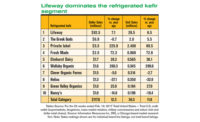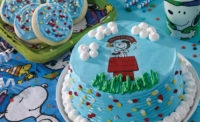One of the best known cultured cream products is sour cream. This dairy product contains approximately 18% fat and approximately 7-9.5% solids nonfat.
One of the best known cultured cream products is sour cream. This dairy product contains approximately 18% fat and approximately 7-9.5% solids nonfat. It is typically packaged in 8- to 16-ounce tubs. We put a dollop of it on our tacos or a baked potato, and mix it with onion soup mix or other flavor packets to make a chip dip. We refer to the product as “cultured” because it typically undergoes fermentation with a lactic acid bacterial culture.
In contrast, when we refer to a person as being highly cultured, it conjures descriptors such as refined, sophisticated, polished and elegant. Why not position our cultured cream products to fit this image? Excuse me, but we are starting with the “cream” of the original milk after all.
A silky smooth mouthfeel
This cream fraction from milk has a lipid system unparalleled in taste and functionality. When it is standardized, processed and fermented into a cultured cream product, it takes on a silky smooth mouthfeel that is coupled with a lusciously decadent rich creamy taste and has a pleasing tangy finish that does not disappoint the palate. If you are skeptical, sit in a quiet room with a spoonful of a high-quality sour cream, close your eyes and try it.
If you make cultured dairy foods, you might ask yourself if the product positioning fits the quality of the product. Is your sour cream package (the first impression of the product the consumer sees) befitting of a sophisticated, elegant product with a silky smooth texture and a luscious creamy taste? Or, is the package a predominantly white 16- to 24-ounce tub that could be easily labeled “generic sour cream”? Does the product messaging (print and other media advertising) remind you of this premium quality or does it sound ho-hum?
Some might say their more generic product positioning supports mainstream mass marketing at a competitive price point. Today, with increased sophistication of the consumer, even the masses are seeking to have something special, and they are willing to pay a premium price.
Producers of crème fraiche (a cultured cream product with up to twice the fat content of typical sour cream) saw this opportunity to redefine this fermented cream product with a little more “culture.” In today’s market, ingredient simplicity helps to define it as high quality. Some dairy brands market their crème fraiche as the only product that goes with caviar, and it only contains one or two ingredients. Products can easily sell for as much as $4-$5 a pint, which reinforces the positioning as the crème de la crème. Dairy processors market cultured dairy products as food ingredients, and they are teaching chefs how to use them effectively to further create demand in fine dining (see www.kendallfarmscremefraiche.com).
Processing cultured dairy foods
Now, being truly cultured cannot just be about the window dressing (packaging and marketing). The product must meet the message of sophisticated elegance to gain repeat purchase. Hence, the dairy processor must be well-versed in bacterial culture selection, cream processing, fermentation and quality assurance. Attention to cream handling, processing and related technology details can ensure that products do not have defects such as weak body, grainy texture, harsh acid flavor, whey separation, yeast and molds or package bulging associated with excessive carbon dioxide production.
Weak body and/or grainy texture can be attributed to several factors, including incorrect formulation, excessive heat treatments, incorrect homogenization, incorrect culture use and lack of precision on fermentation conditions. Whey separation occurs when cream is low in milk protein, there is insufficient acid development or the heat treatment of the cream was incorrect. The common flavor defect of harsh acid taste occurs when diacetyl production is low (insufficient citrate in cream), incorrect cultures are used or incorrect incubation temperatures are used that do not optimize a balance of acid and flavor compound production during fermentation. (For additional information on how to troubleshoot defects in cultured cream products, check out Cultured/Sour Cream, Chapter 18 in “Manufacturing Yogurt and Fermented Milks: by Ramesh Chandan, Ed., 2006; Blackwell Publishing).
Because cultured cream products are used predominantly as a condiment or as an ingredient, they must have the proper ingredient functionality (for example, heat and acid stability for sauces and soups, proper viscosity and mouthfeel for dips and thickening and emulsification for other food applications). New cultures and other ingredients are also being made available that give processors additional tools to enhance existing product functionality, flavor, texture and shelf life or launch new cultured cream product lines to meet today’s more complex consumer expectations.
Recognition of and effective communication to highlight the “true culture” of cultured cream products can create new opportunities and reawaken consumers to the excellent quality and versatility of cultured cream products in fine dining for meals at home or away from the home. When the dairy industry uses the best technology to put out great cultured cream products, they need to proudly dress them up and showcase them.
Phillip S. Tong is professor of dairy science and director of the Dairy Products Technology Center at California Polytechnic State University.
Get our new eMagazine delivered to your inbox every month.
Stay in the know on the latest dairy industry trends.
SUBSCRIBE TODAYCopyright ©2024. All Rights Reserved BNP Media.
Design, CMS, Hosting & Web Development :: ePublishing


